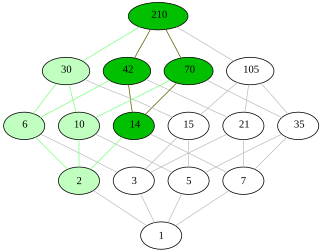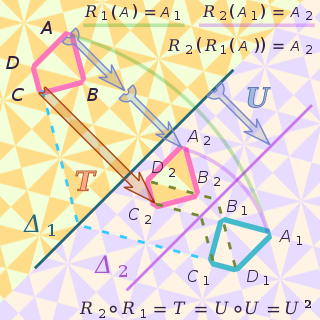In the mathematical field of geometric group theory, a length function is a function that assigns a number to each element of a group.
In the mathematical field of geometric group theory, a length function is a function that assigns a number to each element of a group.
A length functionL : G → R+ on a group G is a function satisfying:
Compare with the axioms for a metric and a filtered algebra.
An important example of a length is the word metric: given a presentation of a group by generators and relations, the length of an element is the length of the shortest word expressing it.
Coxeter groups (including the symmetric group) have combinatorial important length functions, using the simple reflections as generators (thus each simple reflection has length 1). See also: length of a Weyl group element.
A longest element of a Coxeter group is both important and unique up to conjugation (up to different choice of simple reflections).
A group with a length function does not form a filtered group, meaning that the sublevel sets do not form subgroups in general.
However, the group algebra of a group with a length functions forms a filtered algebra: the axiom corresponds to the filtration axiom.

In mathematics, a group is a set with an operation that satisfies the following constraints: the operation is associative and has an identity element, and every element of the set has an inverse element.

In abstract algebra, the symmetric group defined over any set is the group whose elements are all the bijections from the set to itself, and whose group operation is the composition of functions. In particular, the finite symmetric group defined over a finite set of symbols consists of the permutations that can be performed on the symbols. Since there are such permutation operations, the order of the symmetric group is .

In the mathematical field of order theory, an ultrafilter on a given partially ordered set is a certain subset of namely a maximal filter on that is, a proper filter on that cannot be enlarged to a bigger proper filter on

In abstract algebra, group theory studies the algebraic structures known as groups. The concept of a group is central to abstract algebra: other well-known algebraic structures, such as rings, fields, and vector spaces, can all be seen as groups endowed with additional operations and axioms. Groups recur throughout mathematics, and the methods of group theory have influenced many parts of algebra. Linear algebraic groups and Lie groups are two branches of group theory that have experienced advances and have become subject areas in their own right.
In mathematics, rings are algebraic structures that generalize fields: multiplication need not be commutative and multiplicative inverses need not exist. Informally, a ring is a set equipped with two binary operations satisfying properties analogous to those of addition and multiplication of integers. Ring elements may be numbers such as integers or complex numbers, but they may also be non-numerical objects such as polynomials, square matrices, functions, and power series.
In mathematics, a presentation is one method of specifying a group. A presentation of a group G comprises a set S of generators—so that every element of the group can be written as a product of powers of some of these generators—and a set R of relations among those generators. We then say G has presentation

In mathematics, an isometry is a distance-preserving transformation between metric spaces, usually assumed to be bijective. The word isometry is derived from the Ancient Greek: ἴσος isos meaning "equal", and μέτρον metron meaning "measure". If the transformation is from a metric space to itself, it is a kind of geometric transformation known as a motion.
In mathematics, a building is a combinatorial and geometric structure which simultaneously generalizes certain aspects of flag manifolds, finite projective planes, and Riemannian symmetric spaces. Buildings were initially introduced by Jacques Tits as a means to understand the structure of isotropic reductive linear algebraic groups over arbitrary fields. The more specialized theory of Bruhat–Tits buildings plays a role in the study of p-adic Lie groups analogous to that of the theory of symmetric spaces in the theory of Lie groups.

In mathematics, a root system is a configuration of vectors in a Euclidean space satisfying certain geometrical properties. The concept is fundamental in the theory of Lie groups and Lie algebras, especially the classification and representation theory of semisimple Lie algebras. Since Lie groups and Lie algebras have become important in many parts of mathematics during the twentieth century, the apparently special nature of root systems belies the number of areas in which they are applied. Further, the classification scheme for root systems, by Dynkin diagrams, occurs in parts of mathematics with no overt connection to Lie theory. Finally, root systems are important for their own sake, as in spectral graph theory.

In the mathematical field of Lie theory, a Dynkin diagram, named for Eugene Dynkin, is a type of graph with some edges doubled or tripled. Dynkin diagrams arise in the classification of semisimple Lie algebras over algebraically closed fields, in the classification of Weyl groups and other finite reflection groups, and in other contexts. Various properties of the Dynkin diagram correspond to important features of the associated Lie algebra.

In mathematics, in particular the theory of Lie algebras, the Weyl group of a root system Φ is a subgroup of the isometry group of that root system. Specifically, it is the subgroup which is generated by reflections through the hyperplanes orthogonal to the roots, and as such is a finite reflection group. In fact it turns out that most finite reflection groups are Weyl groups. Abstractly, Weyl groups are finite Coxeter groups, and are important examples of these.
In mathematics, a Coxeter group, named after H. S. M. Coxeter, is an abstract group that admits a formal description in terms of reflections. Indeed, the finite Coxeter groups are precisely the finite Euclidean reflection groups; for example, the symmetry group of each regular polyhedron is a finite Coxeter group. However, not all Coxeter groups are finite, and not all can be described in terms of symmetries and Euclidean reflections. Coxeter groups were introduced in 1934 as abstractions of reflection groups, and finite Coxeter groups were classified in 1935.
In mathematics, a Heyting algebra (also known as pseudo-Boolean algebra) is a bounded lattice (with join and meet operations written ∨ and ∧ and with least element 0 and greatest element 1) equipped with a binary operation a → b of implication such that (c ∧ a) ≤ b is equivalent to c ≤ (a → b). From a logical standpoint, A → B is by this definition the weakest proposition for which modus ponens, the inference rule A → B, A ⊢ B, is sound. Like Boolean algebras, Heyting algebras form a variety axiomatizable with finitely many equations. Heyting algebras were introduced by Arend Heyting (1930) to formalize intuitionistic logic.
A lattice is an abstract structure studied in the mathematical subdisciplines of order theory and abstract algebra. It consists of a partially ordered set in which every pair of elements has a unique supremum and a unique infimum. An example is given by the power set of a set, partially ordered by inclusion, for which the supremum is the union and the infimum is the intersection. Another example is given by the natural numbers, partially ordered by divisibility, for which the supremum is the least common multiple and the infimum is the greatest common divisor.
In group theory, a word metric on a discrete group is a way to measure distance between any two elements of . As the name suggests, the word metric is a metric on , assigning to any two elements , of a distance that measures how efficiently their difference can be expressed as a word whose letters come from a generating set for the group. The word metric on G is very closely related to the Cayley graph of G: the word metric measures the length of the shortest path in the Cayley graph between two elements of G.
In mathematics, a Coxeter element is an element of an irreducible Coxeter group which is a product of all simple reflections. The product depends on the order in which they are taken, but different orderings produce conjugate elements, which have the same order. This order is known as the Coxeter number. They are named after British-Canadian geometer H.S.M. Coxeter, who introduced the groups in 1934 as abstractions of reflection groups.
In mathematics, an automatic group is a finitely generated group equipped with several finite-state automata. These automata represent the Cayley graph of the group. That is, they can tell if a given word representation of a group element is in a "canonical form" and can tell if two elements given in canonical words differ by a generator.
In the mathematical field of representation theory, a Kazhdan–Lusztig polynomial is a member of a family of integral polynomials introduced by David Kazhdan and George Lusztig. They are indexed by pairs of elements y, w of a Coxeter group W, which can in particular be the Weyl group of a Lie group.

The affine symmetric groups are a family of mathematical structures that describe the symmetries of the number line and the regular triangular tiling of the plane, as well as related higher-dimensional objects. In addition to this geometric description, the affine symmetric groups may be defined in other ways: as collections of permutations (rearrangements) of the integers that are periodic in a certain sense, or in purely algebraic terms as a group with certain generators and relations. They are studied in combinatorics and representation theory.
In the mathematical theory of reflection groups, the parabolic subgroups are a special kind of subgroup. The precise definition of which subgroups are parabolic depends on context—for example, whether one is discussing general Coxeter groups or complex reflection groups—but in all cases the collection of parabolic subgroups exhibits important good behaviors. For example, the parabolic subgroups of a reflection group have a natural indexing set and form a lattice when ordered by inclusion. The different definitions of parabolic subgroups essentially coincide in the case of finite real reflection groups. Parabolic subgroups arise in the theory of algebraic groups, through their connection with Weyl groups.
This article incorporates material from Length function on PlanetMath, which is licensed under the Creative Commons Attribution/Share-Alike License.